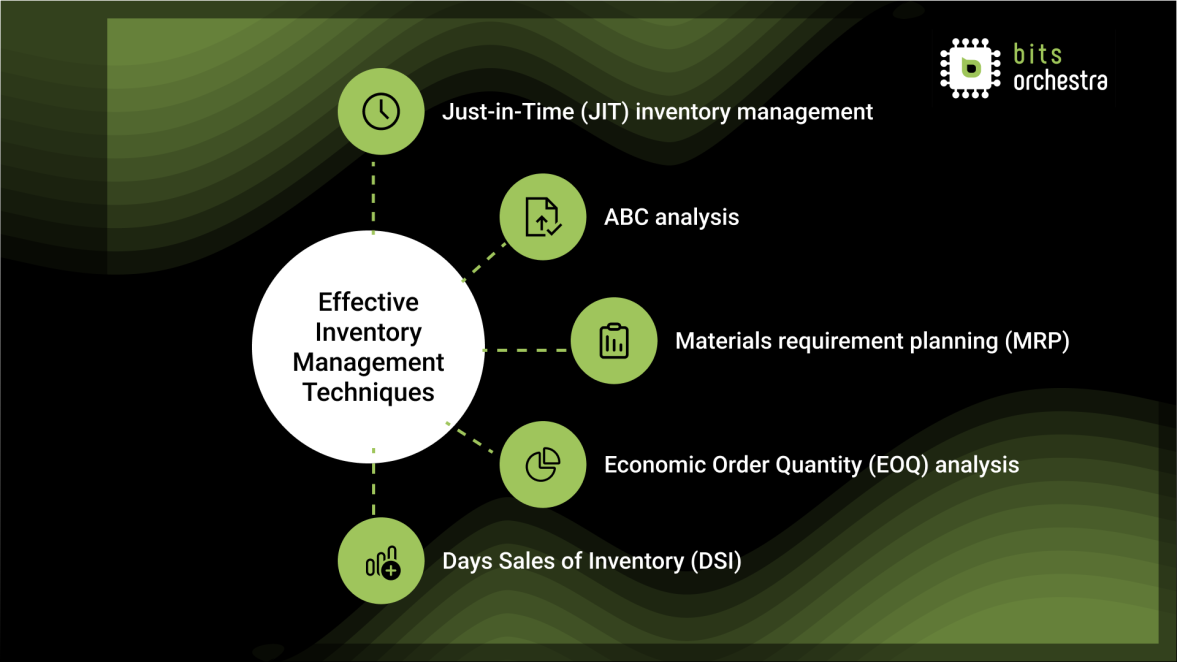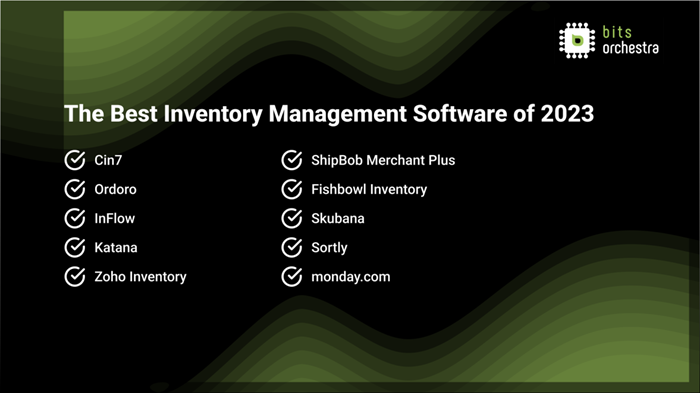Inventory management: automation and best inventory practices
KEY TAKEAWAYS
-
The concept of inventory management refers to the entire process of managing inventories, starting from raw materials to finished products.
-
Inventory management ensures that inventories are managed efficiently and that neither gluts nor shortages exist.
-
As far as inventory management is concerned, four main techniques must be employed: just-in-time management (JIT), materials requirement planning (MRP), economic order quantity (EOQ), and days sales of inventory (DSI).
What is inventory management?
Inventory management is an important process for any business. It involves ordering, storing, using, and selling a company's inventory, including raw materials, components, finished products, warehousing, and processing.
Inventory management involves:
-
Setting minimum and maximum inventory limits.
-
Determining the size of inventory to maintain.
-
Deciding the issue prices for the inventory.
Managing your inventory well is crucial for any business since it ensures you have enough stock to meet customer demand without overstocking. Inventory management also helps to identify any inefficiencies in the supply chain, which can be addressed to improve the organization's overall efficiency.
Process of Inventory Management
Inventory management begins with the process of forecasting inventory needs. Forecasting helps identify how much of each item should be stocked to meet upcoming customer demand. Once the forecasting process is complete, inventory managers must create a plan to ensure that all products are stored most effectively.
By monitoring performance, inventory managers can identify areas that need improvement and adjust their inventory management plan accordingly. This process is part of monitoring customer demand, analyzing customer trends, and reviewing inventory reports regularly.
Effective Inventory Management Techniques
Organizations can use inventory control techniques to increase efficiency, cut costs, and maintain compliance. All these inventory management techniques help companies achieve customer satisfaction, growth, and profitability.
-
Just-in-Time (JIT) inventory management
This inventory management technique emphasizes working closely with vendors by acquiring materials before their requirements arise. Such a system minimizes inventory levels by ordering and storing only the necessary items. It also helps reduce the risk of overstocking, as stock is only ordered when needed.
The goal of JIT inventory is to ensure that there is always enough stock to produce what is needed when it is needed. This helps to reduce waste and costs associated with overstocking and overproducing. By ensuring that only the necessary items are produced at the right time, JIT inventory allows companies to maximize their efficiency and minimize their costs.
-
ABC analysis
Under the ABC method, inventory is classified in order of profitability, which allows owners and managers to identify where the most profitable investments should be made. Based on their value, revenue share, and control requirements, the products are classified into three types: A, B, and C. Using Activity Based Costing (ABC), a company allocates overhead and direct expenses to its most important activities.
ABC analysis is a valuable tool for inventory management, as it helps businesses focus their efforts on the items that are most critical for their company's success. It also helps to reduce costs associated with carrying excess inventory, as well as encouraging efficient use of resources by understanding the value of each item. By using ABC analysis, businesses can better understand their inventory and make more informed decisions about which items to focus on.
-
Materials requirement planning (MRP)
Material requirements planning (MRP) is a system that helps to manage the materials and components required to manufacture a product. It is composed of three main steps:
-
Taking stock of the materials and components currently on hand
-
Determining the additional material and components needed
-
Scheduling the production or purchase of these additional items
MRP is an invaluable tool for managers who are looking to optimize their production process. By inputting the necessary data into the MRP system, managers can generate a bill of materials, calculate purchasing and production requirements, track production activities, and adjust production plans and schedules. All of these features enable managers to improve their production efficiency and reduce costs, ensuring that their business remains competitive in the marketplace.
-
Economic Order Quantity (EOQ) analysis
The EOQ model works by determining the optimal batch size of inventory to order at one time. This batch size is determined by considering the demand for the product, the cost of ordering, and the cost of holding the inventory. By finding the batch size that minimizes total inventory costs, the model ensures that the right amount of inventory is ordered at the right frequency.
The Economic Order Quantity (EOQ) model is a powerful tool for managing inventory in a business. It seeks to balance the costs of ordering too frequently with having too much inventory on hand. In order to accomplish this, it assumes that inventory holding costs and setup costs are trade-offs. By optimizing these costs, the total inventory cost can be minimized.
-
Days Sales of Inventory (DSI)
Days' sales of inventory (DSI) measures how efficiently a firm sells off its inventory. During a period, average inventory is divided by the cost of goods sold during that period and multiplied by the number of days during that period. A low DSI indicates a company can quickly sell off its inventory. At the same time, a high DSI can signify that a firm is not properly managing its inventory or has inventory that is difficult to sell. A company's DSI can provide investors with valuable information about how well its inventory is managed.

Picture 1. Effective inventory management techniques.
Other Inventory Management Techniques
Safety stock inventory.
A safety stock strategy helps prevent stock-outs, disrupts the supply chain, and ensures customer orders are fulfilled on time. It is typically ordered in addition to the planned inventory to cover any unexpected changes in customer demand or forecasting errors.
LIFO and FIFO are standard methods used to determine the cost of goods. FIFO, or first-in, first-out, means that the oldest inventory is sold first to maintain the inventory's freshness. This is done to ensure that the older items are used before they expire. On the other hand, LIFO, or last-in, first-out, assumes that the newer inventory is sold before the older inventory to prevent the inventory from going bad. In this way, the newer items are used up before they expire.
Reorder point formula.
The reorder point formula is critical for businesses to ensure adequate inventory levels. It is calculated by considering the product's demand, the lead time to receive the product from the supplier, and the safety stock number. The reorder point is typically higher than the safety stock number to factor in any potential delays in receiving the product from the supplier.
Batch tracking.
Drop shipping allows retailers to sell products without holding inventory. Suppliers ship goods directly to customers on behalf of retailers. Batch tracking is an essential quality control technique enabling users to group and track similar goods. This process helps to monitor inventory expiration dates and identify defective products by tracing them back to their original batch. In particular, this can be helpful for companies dealing with food, pharmaceuticals, and other perishable products.
Consignment inventory.
The consignee must carefully track their consignment inventory, as they are responsible for items not sold or damaged. Keeping track of inventory requires a record of the items received, their quantity and cost, and when the consignee is to be paid. Additionally, the consignee should also track any items that have been returned or exchanged so that the consigner can be reimbursed.
Perpetual inventory management.
Perpetual inventory management is a straightforward inventory tracking method that lets businesses stay updated with their stock in real time. As soon as the inventory arrives, it is counted and recorded. This inventory management system can be managed manually or with a spreadsheet, but it can also be automated with devices that scan product barcodes or RFID tags.
Dropshipping.
Retailers can sell products using the drop shipping method without holding inventory. Suppliers ship goods directly to customers on behalf of retailers. This means that businesses can offer their customers a wider variety of products without holding any of the inventory themselves.
Dropshipping is an attractive option for entrepreneurs because it allows them to start an online business with a much lower initial investment than traditional retail businesses. Additionally, because the supplier handles the inventory and shipping, it is much easier for entrepreneurs to manage their businesses as they don't need to worry about stocking or shipping products.
Lean Manufacturing.
In lean manufacturing, non-value-adding activities or processes are identified and eliminated. It is based on creating a continuous production flow and minimizing waste while reducing operating costs and improving customer satisfaction.
By identifying and eliminating non-value-adding activities, lean manufacturing helps to create a more efficient and productive process. In turn, this results in increased customer satisfaction and lower costs.
Six Sigma.
Six Sigma is a data-driven approach to improving the performance of businesses. Quality management methods are used to identify and eliminate defects in processes, products, and services.
The Six Sigma approach reduces variability in processes and products and ultimately improves the bottom line. With Six Sigma, businesses can effectively identify and eliminate sources of variation in their operations, allowing them to achieve maximum efficiency and profitability.
Lean Six Sigma.
Lean Six Sigma is a method of improving performance and efficiency that combines the tools of Six Sigma with an emphasis on customer focus and continuous improvement. It is an approach to process improvement that seeks to identify and reduce waste, reduce variation, and increase customer satisfaction.
Demand forecasting.
Demand forecasting helps businesses plan for the future by predicting customer demand. Companies use historical sales data to build models that accurately predict the demand for their products or services. This helps companies anticipate the volume of goods and services they should produce and the inventory they should stock to meet customer needs.
Cross-docking.
Cross-docking is a technique that many suppliers use to ensure efficient and timely delivery of materials. It involves unloading materials from the supplier truck directly into the outbound truck, thus eliminating warehousing and storage between deliveries. This means the material is delivered to the customer as soon as it is unloaded from the supplier truck. It is a Just-in-Time (JIT) shipping process that reduces costs, eliminates inventory, and improves the customer experience.
Bulk shipments.
Bulk shipments provide an efficient and cost-effective way to transport large amounts of goods, as the lack of packaging and parceling reduces the cost involved in the shipping process. Bulk shipments are shipments that do not involve any packaging. The cargo is loaded directly into the holds of the shipping vessel without being parceled or split into individual packages. Bulk shipments can include various goods, from raw materials to finished products. This type of shipment is most commonly used to transport large quantities of items, such as oil, coal, grain, or ore.
Regarding shipping products, bulk shipments offer a cost-effective way for businesses to send their inventory. By palletizing the goods, companies can send more products at once. This shipping method can be especially beneficial for B2C and B2B merchants.

Picture 2. Other inventory management techniques.
The Importance of Inventory Management
In supply chain management, inventory management plays an important role that cannot be denied, especially from a management standpoint. It involves tracking stock levels and the movement of goods, whether raw materials for manufacturers or finished products for customers.
An organization's inventory management is also crucial to its long-term success. It helps reduce costs, improve cash flow, and boost profitability by ensuring you have the proper stock levels at the right time. With adequate inventory management, you cannot experience a range of common mistakes such as mis-shipments, shortages, out-of-stock, and spoilage. Overstocks can also occur, resulting in further losses for your business.
Inventory management software
Inventory management software is becoming increasingly popular among businesses of all sizes, from small operations to large corporations. The software helps businesses automate their inventory processes, operate efficiently, and increase profits. Whether a business operates in the retail, manufacturing, or service industry, inventory management software can help streamline operations, enhance customer service, and improve profitability.
The Best Inventory Management Software of 2023
-
Cin7: All-around winner
-
Ordoro: The best solution for multichannel sellers
-
InFlow: Ideal for businesses that deal with other businesses (B2B) and wholesalers
-
Katana: The best choice for manufacturers
-
Zoho Inventory: Value-for-money inventory management software
-
ShipBob Merchant Plus: The best hybrid fulfillment solution
-
Fishbowl Inventory: Perfect for QuickBooks users
-
Skubana: Ideal for FBA and dropshippers
-
Sortly: Ideal for tracking assets and small retailers
-
monday.com: One of the best free inventory management applications
(Source: Forbes.com)

Picture 3. Inventory management software.
Why inventory management software matters
There is no doubt that technology has revolutionized the way businesses operate in the field of inventory management. Managing your inventory can better understand your entire stock, reduce human error by automating critical tasks, and reduce the burden of operating your business by taking the legwork out of it.
Finding the right platform for your business can be challenging, especially with so many options on the market that all claim to be your best solution. Make the best inventory management decision for your business by identifying your needs and matching them with research and reviews of prospective vendors.
How should manufacturers choose inventory management software?
-
Product cost analysis is an integral part of running a successful business. A good product cost analysis tool can help you track and manage your raw materials and finished goods, ensuring you always have the right inventory levels. It can also be used to predict labor and operating costs, such as machinery acquisition and maintenance expenses.
An inventory management system with a bill of materials will allow you to perform accurate cost analysis. This will provide a detailed breakdown of cost components, including descriptions of each cost item. By understanding all cost components, you can make more informed decisions about your budget and production costs. -
Demand forecasting is an important tool for inventory management, providing analysis of historical production and sales data to predict future order management needs. Software with a forecasting feature provides an efficient and accurate way to plan for future production and inventory needs, allowing companies to stay ahead of their competition and maintain a reliable supply of products.
-
Inventory software with e-commerce integration allows manufacturers to streamline sales to retail clients, providing an efficient and cost-effective way to manage sales and inventory. Manufacturers can save time and money by taking advantage of e-commerce integrations while providing customers with an enhanced shopping experience. Manufacturing companies can maximize profits with the right inventory software and e-commerce integration.
Inventory Software Development with Bits Orchestra
Bits Orchestra is committed to helping companies develop custom software solutions for inventory management. Our specialty is providing reliable, cost-effective inventory management solutions. Our team of experienced developers, Big Data engineers, Business Intelligence, Data Science experts customizes each project. Furthermore, we provide ongoing support and maintenance to keep customers' inventory management systems up-to-date. Business owners who wish to manage their software inventory should consider Bitsorchestra when designing the ideal software inventory.
Author
Roman Hutnyk



_1.jpg?width=270&height=270&ext=.jpg&maxsidesize=338&resizemode=force)







